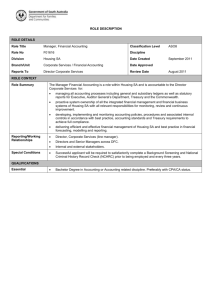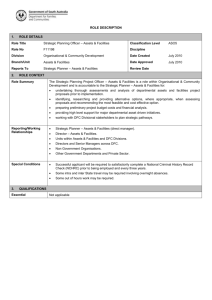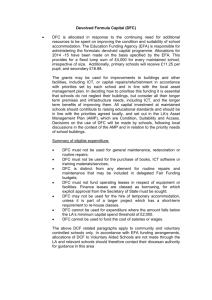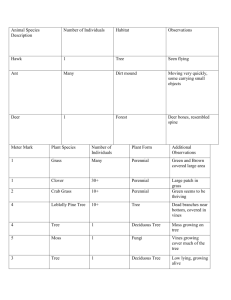The DFC Model - Growth Model Users Group
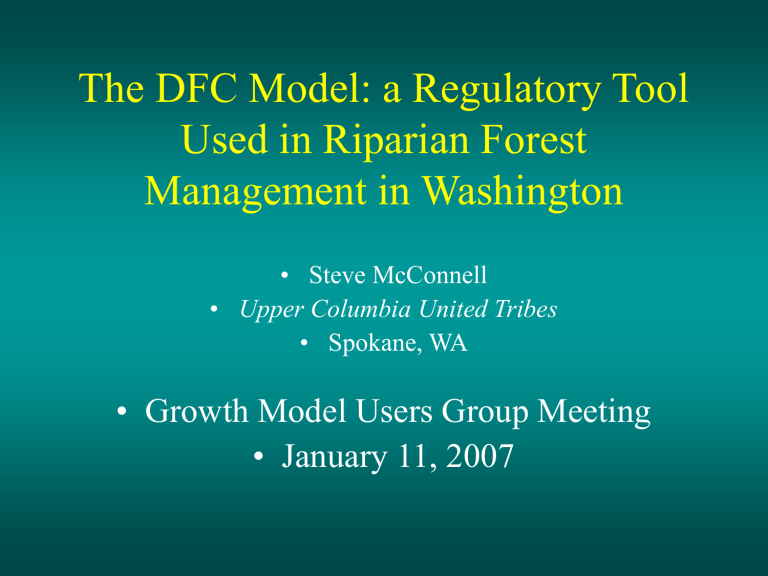
The DFC Model: a Regulatory Tool
Used in Riparian Forest
Management in Washington
• Steve McConnell
• Upper Columbia United Tribes
• Spokane, WA
• Growth Model Users Group Meeting
• January 11, 2007
Acknowledgements
• NWIFC, CMER, UCUT
• John Heimburg
• Dave Schuett-Hames, Ash Roorbach
• Chris Mendoza, Pete Heide
• Doug Martin, Nancy Sturhan
• Darin Cramer, Dawn Hitchens and Bonnie
Thompson
Presentation Outline
• DFC Model Attributes and Role in
Management
• Desired Future Condition (DFC) management concept
• Key attributes of DFC Rules
• DFC Model role in management
• Model origins and characteristics
• Overview of CMER DFC related studies
DFC Model
• Only growth and yield model used as a regulatory tool
• Derived from ORGANON, SMC version
• A whole stand model
DFC Model
• Utilizes landowner collected data
• Simple enough for lay-persons to use
• Limited number of outputs – only those that pertain directly to what landowners need to know to implement rules
DFC Model Role
• Project stand basal area growth from current age to stand age 140
• Determines if stands will meet DFC Target
• Provides prescriptive details based on site and stand characteristics
• Takes a very complicated set of rules and makes them comprehensible!
Characteristics of DFC Rules for
Riparian Forests
• Fish-bearing streams on private forest lands in western Washington
• Core, Inner and Outer Zones
• Zone widths vary by site class (I-V) and stream size (LE or GT 10’)
• The DFC target is a stand-age-140 basal area target, for each site class
DFC: Desired Future Condition
•
Characteristics and functions of mature, unmanaged riparian forests
–
Habitat conditions desirable for salmon recovery
DFC: Desired Future Condition
•
Goal-oriented management system
• “…The stand conditions of a mature riparian forest, agreed to be 140 years of age …a reference point on a pathway and not an endpoint for stands.”
• Gauged against a stand basal area target
Management Along Westside,
Type F Streams Varies By:
• Site productivity: site class I-V
• Stream-size: LE 10’ vs. GT 10’
• Harvest method:
– no-cut
– thin from below
– leave trees closest to the stream
RMZ’s: a Graphical Depiction
• Zones – core, inner and outer
RMZs: Location, Activities
Allowed and Size
•
Core Zone : closest to stream, no cutting, always 50’ wide
•
Inner Zone : some cutting, variable width
(10 to 100 feet)
•
Outer Zone : furthest from stream, more cutting, variable width (22 to 67 feet)
RMZ Widths, by Stream Size
120
100
80
60
40
20
0
Inner and Outer Zone Widths for Current "DFC"
Rules iz small iz large oz small
Zone and stream size com bination oz large
I
II
III
IV
V
Forest Practices Rules Stand
Age-140 Basal Area Targets
285
Basal Area Target
275
258 300
200
100
0
224
190
I II III
Site Class
IV V
Stand Basal Area for DFC Rules is Calculated from the Area-Adjusted Core+Inner zones
DFC: Desired Future Condition
•
Management today that puts stands on a trajectory towards
“DFC”
•
Stand growth and
Rx details derived from the DFC Model
DFC Model Problems
• Three errors in DFC Model calculations were identified, none of them making significant differences to the desktop analysis but possibly affecting implementation
DFC Model Problems
• 1) Stand age 140 BAPA is inflated for stands younger than 35 years,
• 2) An incorrect value is used in for small stream site class 1, 2, and 3 per acre calculations
• 3) For Option 1, the DFC Model gives different inner zone leave tree numbers on the graphical interface than are counted in the inner zone stand table
Desktop Analysis Results
10
8
6
4
2
0
Inner Zone Area vs. the Number of Trees per Acre
Represented by a Single Tree in DFC Model
Calculations for the Thin-from-Below Prescription
Number ofTrees per Acre
Represented by One Tree
Area of Inner Zone
Stands (Acres)
Individual Stands
Sensitivity Analysis (Roorbach)
• Scrunches variability for most input variables, minimizing the difference in stand age 140 Basal Area
• Major Species, DF or WH, makes an important difference in DFC Model outputs– the largest DFC Model related difference found
DFC Model Related Reports
• Desktop analysis
• Riparian stand characteristics
• Sensitivity analysis (Roorbach et al.)
• FPA field check review
• Model and manual problems
• Synthesis
Desktop Analysis: Exploratory
Origins
Initial analyses were:
– unstructured; outcomes were evaluated without specific objectives.
– from a small sample of FPAs from the
Olympic Peninsula,
– from FPAs that were approved just after new rules were developed
Desktop Analysis: Exploratory
Results
• Noticed that projected ba-140 almost always exceeded rule ba target
• Determined that the required 57 ltpa was a constraint to inner zone timber harvest
• Later, determined that the option 2 minimum floor width also constrained timber harvest more than the rule ba target.
Desktop Analysis: Follow-up
Exploratory Study
• Developed a Study Design (was not reviewed by the SRC)
• Developed specific objectives
Desktop Analysis Follow-up:
Study Design
• Selected 150 FPAs from 2003 and 2004, 75 from each year
• Used first DFC worksheet from each FPA
• Developed criteria for rejecting FPAs that lacked data or did not meet criteria
Desktop Analysis Follow-up:
Objectives
• Quantify DFC model-projected BA-140 for each of three riparian prescriptions: 1) nocut, 2) thin-from-below, and 3) leave trees closest to the stream
• Determine the effect of rule components
(required leave trees – option 1, and required floor widths, option 2) on DFC
Model BA-140 projections
Desktop Analysis Results
Core+Inner Zone BA-140 by Rx's, across all Site Classes
366.3
335.9
299.2
500
400
300
200
100
0
150 150 108
Riparian Prescription no-cut
Opt-1
Opt-2
Desktop Analysis Results
500
400
300
200
100
0
Stand Age 140 Basal Area per Acre, by Site Class and Riparian Prescription
1 2 3
Site Class
4 5 no-cut
Opt-1 opt2
Desktop Analysis Results
DFC Model After Thin Leave Trees per Acre, by Rule
Constaint, for the 140 Stands Requiring 60 or fewer
Residual Trees per Acre
One Stand Constrained by basal area
61
60
All other, 138 out of 140 Stands,
59
Constrained by
58 Trees per Acre
57
56
One Stand Constrained by Basal Area
AND Trees per Acre
Individual Stands
Desktop Analysis Results
DFC Model After Thin Leave Trees per Acre, by Rule
Constraint, for the Ten Stands Requiring More Than 60
Residual Trees per Acre
100
90
80
70
60
6 0 . 8
Stands Constrained by TPA
<=
6 1. 5 6 2 . 2
6 3 . 7
Stands Constrained by Basal Area
=>
6 4 . 9
7 0 . 9 7 1. 5
Individual Stands
7 2 . 8 7 3 . 1
9 7 . 0
Desktop Analysis Results
500
400
300
200
100
0
-100
Timber Harvest Constraints for the Thin From Below
Prescription: Trees Per Acre and Basal Area per Acre
7 stands constained by basal area only
142 stands constrained by
trees per acre only
1 stand constrained by basal area
AND trees per acre
Trees per Acre basal area
Riparian Stands, Sorted by Ascending Stand Age 140 Basal Area,
Minus One Tree
3
1
2
2
1
Site
Class
Desktop Analysis Results
Steam
Size
Floor
Width
Average floor width plus and minus one standard deviation
Number of
Stands
Constrained by
Floor Width
Number of
Stands
Constrained by
Basal Area
Target
Tot al
103.0
12.6
Small
80’
0 5 5
Large
Small
Large
100’
80’
100’
102.0
4.0
87.4
7.1
102.6
5.7
80.4
1.8
3
7
20
1
25
7
4
32
Small 80’ 38 2
27
40
Desktop Analysis Results
300
200
100
0
400
Floor Width and Basal Area Credit for Site
Class 2, Large Stream Stands
360.5
120'
0
100'
Individual Stands credit floor
Desktop Analysis: Conclusions
• DFC model projected core+inner zone BA-
140 exceed rule targets, because
• The 57 iz ltpa (opt-1) almost always (95.3% of worksheets reviewed) required leaving more trees than the rule target alone
• The minimum floor widths (opt-2) usually
(63% of worksheets reviewed) required leaving more trees than the rule target alone
Riparian Stand Characteristics
• Applicable only to subset of riparian stands that meet DFC requirements and selected by landowner for harvest
• Provide an overview of characteristics of stands submitted by landowners for management under current rules
• A few highlights only
Site and Stand Analyses:
Site Class
Numbe r of Riparian Stands by Site Class and DNR Re gion
50
40
30
20
10
0
0 1 2 1 0
NW
45
39
25
9
0
4 3
0
OLY PC
DNR Region
2
0 0
9 8
1 1
SPS
3
4
1
2
5
Site and Stand Analyses:
Major Species
Number of Riparian Stands by Major Species and
60
DNR Region
55
50
40
30
20
10
0
1
3
8
38
26
10
9
NW OLY PC SPS
DNR Region
DF
WH
Site and Stand Analyses:
HA BA by Major Species
Core vs. Inner Zone Harvest Age Basal Area by
Major Species
400
350
300
250
200
150
100
50
0
For DF, n = 74 Core Inner
For WH, n = 76 Riparian M anage me nt Zone
DF
WH
Site and Stand Analyses:
Conclusions (Cont.)
• Most stands (88.7) were on Site Class 2 and
Site Class 3
• There was an almost even split in # of FPAs evaluated,by Species (74 DF and 76 WH)
• In core zones, on average, basal area and trees per acre were higher, and percent conifer lower
Site and Stand Analyses:
Conclusions (Cont.)
• Stands with WH as major species had higher tpa, ba, and RD, but lower qmd than stands with Douglas-fir as major species
DFC Field Check Study
• Most stand inventory and site attribute data collected were similar between landowner and CMER Staff
– Stream size
– Major species
– Stand age
– Stand inventory
DFC Field Check Study
• Biggest differences to buffer strip configuration are a result of stream size call,
CMZ delineation and landowner decision on outer zone trees
DFC Field Check Study
• There were methodological findings, for example:
• 1) there is no method prescribed for determining RMZ length and this can lead to a lot of variability,
• 2) the Board Manual and other materials provided to landowners are confusing, difficult to follow and have errors within
Synthesis
• The basal area target is a less important constraint to inner zone timber harvest than is the leave tree requirement or minimum floor width
• Landowners use Option 2 (leave trees closest to the stream) preferentially
Synthesis
• There may be differences in harvest age
Douglas-fir and western hemlock stands in terms of basal area, tpa, relative density, qmd and conifer percent. Possibly there should be different management prescriptions for these.

